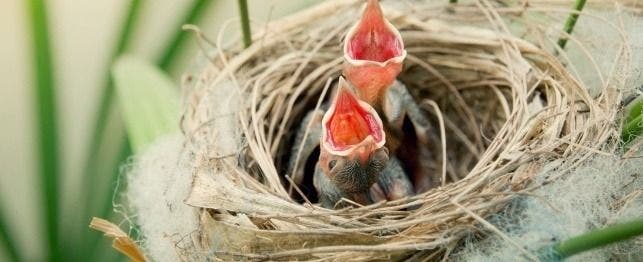
Foster Care of Orphan Wild Baby Birds
In the spring, it’s common to find baby birds away from their nests. Your first thought might be that the bird is in trouble, but this is not always the case. So, when should you intervene?
Uninjured baby birds with feathers should be left alone. These are fledglings that typically hop on the ground. The parents are probably nearby. If the baby bird does not have feathers, either put the baby back in the nest or make a substitute nest by poking holes in the bottom of an empty margarine tub and lining it with dry grass or pine needles. Leave the bird in the nest and observe him from a distance. If one of the parents does not visit within an hour, the baby needs help.
If you find a stranded baby bird, the best thing you can do for him is to contact a wildlife rehabilitation center. These facilities give orphaned babies the best chance of survival. If there is no wildlife center in your area that cares for orphan wild birds, you should be aware that only certain species are legal for people to rehabilitate. Pigeons, starlings and sparrows are typically the only species that you should attempt to hand raise. Other species may be protected by the U.S. Fish & Wildlife Service.
Guidelines
The most important things about trying to foster and rehabilitate wild birds is to offer a variety of food, keep the cage clean and be consistent when feeding. Your care will mimic care received in the wild. Try to keep in mind that these babies are being raised as their wild mother would raise them.
Always wash your hand before and after caring for the birds to prevent contracting an infection. Periodic daily access to sunshine is very important but you must make sure the birds do not overheat. If you place the cage outside, make sure it is predator-proof.
Birds must be able to fly and eat on their own before they can be released.
Housing
Keeping the cage clean is very important. With smaller cages, cleaning is easier. Once the baby is fed, he immediately wiggles his back end to the wall of the nest, raises his rear and defecates right out of the nest. This keeps the nest clean and your job as foster mom easier, since all you do is pick up feces outside the nest with a tissue.
For hatchlings, babies without feathers and eyes closed, a small box with a light cover, such as a small shoebox, works well. The temperature of the housing should be around 85 to 90 degrees Fahrenheit. A heating pad set on low can be used to keep the cage warm.
For a bird with eyes opened and feathers, move him to a larger cage. A small laundry basket or box can work. A secure lid such as fiberglass screening or sweater dryer screen can be used. For either housing, line the bottom with a sheet of plastic, newspaper and paper towels. Change layers often to keep clean. Twigs can be used for perches. Make sure they are high enough so that the tails do not scrape the bottom.
For active fledglings, one laundry basket inverted on another and clipped together, a small playpen or appliance box usually works.
Feeding
For hatchlings, feed commercial baby bird food found in pet stores. Fledglings can be fed a mix of baby bird food, mealworms, insects and wheat bread. Nuts, chopped apples, sunflower seeds and alfalfa sprouts can also be offered.
Before feeding, always make sure the crop is empty. Then place the food in the back of the mouth, past the windpipe.
Naked hatchlings with eyes closed will need to be fed every 20 minutes morning till night. As night approaches, stop feeding and put the babies to bed.
Once their eyes have opened and their feathers are well started, you can stretch out feeding times to every 30 minutes, 45 minutes, hourly and eventually every 2 hours. By the time they hop out of their nests they should be on an hourly schedule. After about 10 days, feeding can be reduced to every 2 to 3 hours.
As soon as fledglings are perching, put small dishes of chopped mealworms, fruit or soaked dry dog food in the cage. Offer them food from the dish with blunt nosed tweezers or fingers. Encourage them to eat. Do not expect them to eat much on their own at first but keep showing them where you are getting the food. Place a small water dish in the cage. Add a few rocks to prevent drowning.
By 4 weeks of age, they should be self-feeding. They might try to get you to sneak them a handout by screaming. A few times a day, hand feeding is okay but you are trying to encourage them to eat on their own.
Twice a day they should be misted and a shallow dish should be available for bathing. This stimulates preening. Without waterproofing, feathers will not repel water. This will not only inhibit flying, but will also affect their ability to stay warm.
Development of Certain Bird Species
Sparrows
- Eyes open within 1 week
- Feathered by 10 days
- Flying well by 2-3 weeks
- Eating on own by 5 weeks
- Release at 6-7 weeks, with feeding available (bird feeder)
Starlings
- Eyes open within 1 week
- Flying well by 3 weeks
- Self feeding at 4 weeks
- Release when tail feathers are full length and the bird is completely self feeding (7-8 weeks)